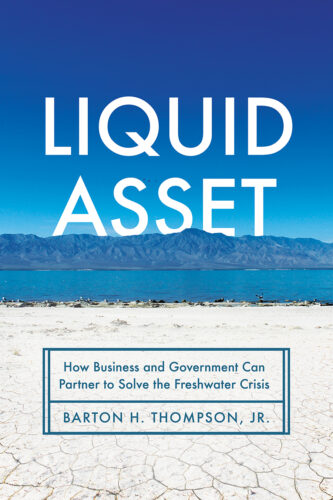Liquid Asset
Buzz Thompson on How Business Government Partnerships Can Help Solve the Water Crisis
Access to clean water is a human right, South Africa’s constitution declared in 1996. That’s what the courts in India ruled in 2000 and what 122 member states of the United Nations approved in 2010. The government of California signed on to the idea in 2012. But no matter how many institutions assert this right, it is usually honored in the breach. Declarations are one thing. It’s another to make clean water universally available and affordable.

Barton H. “Buzz” Thompson Jr. wades into the debate with a new book, Liquid Asset: How Business and Government Can Partner to Solve the Freshwater Crisis. Its focus: how water managers can team up with the private sector—consultants, water delivery companies, inventors, and financial firms—to overcome the daunting obstacles to making safe, affordable, and sustainable water a reality everywhere. The obstacles include growing populations, growing demand, and climate change-driven droughts. Aside from hurricanes, Thompson writes, “Droughts currently cause greater economic loss than any other form of natural disaster.”
Thompson, JD/MBA ’76 (BA ’72), the Robert E. Paradise Professor of Natural Resources Law, has been up close and personal with water complexities and water law for half a century. He started the law school’s Environment and Natural Resources Law & Policy Program and, as the faculty director of Stanford’s Water in the West program, he knows the emotions water evokes. Putting the words “water” and “privatization” in the same sentence can be a hazard.
But given the critical imbalance between water supply and demand, Thompson is willing to risk the hazard. In Liquid Asset, he argues that the private sector’s capabilities for managing the resource and rebuilding crumbling systems are too important to ignore. “The private sector will not solve local water shortages by itself,” he writes, “but it can be a powerful force.”
He believes water markets can ensure the best distribution of a dwindling resource.
The idea of markets can touch a nerve. How can one trade in a public good? The book’s answer: under the eye of a public watchdog. As proprietors of a business with shrinking supplies and deteriorating infrastructure, government-run water utilities need help. Markets can help ensure that water gets where it is most needed.
“The shift toward greater private involvement has been slow, rocky, [and] largely incomplete,” he writes, even though “the private sector can sometimes bring immense value to water management. The trick is to understand where and under what circumstances it can do so safely.” If the risk of profiteering—or the appearance of profiteering—can be managed, the potential benefits include the new capital needed to rebuild dilapidated infrastructure.

In 2019, the Government Accountability Office found that among the roughly 50,000 U.S. drinking water utilities, 14 publicly traded companies serve customers in 33 states. About 10 percent of the population gets water from private companies. The GAO report estimated that needed repairs or replacement of infrastructure will cost $470 billion over two decades.
Partnerships between private firms and municipal companies, Thompson argues, offer benefits from increased expertise in designing infrastructure to cutting building costs and sharing financial risks. Thompson does, however, include the story of a partnership gone south: When the Pittsburgh Water and Sewer Authority hired the French multinational Veolia, the partnership produced significant savings, but on its watch, lead contamination increased.
Management expertise and ready access to capital are two significant advantages that private enterprise can bring to the thousands of small water agencies that don’t have the size or financial heft to look for innovative technologies or new financial structures to make their job easier. For instance, when it comes to groundwater basins all over the world, but particularly in the American Southwest, overdrafts and sinking land can thwart the prospects of continued access to the aquifer. Small water districts have trouble measuring and thus controlling use. Private firms provide satellite-based data on groundwater use and it is increasingly available to small agencies.
Liquid Asset focuses on how private companies may be able, through consolidation or joint management, to compensate for the fragmentation of the water industry in the United States. As the author points out, “While 40 percent of Americans receive water from large or very large systems, more than 80 percent of the systems serve less than 500 customers.”
“High fragmentation among water supplies can undermine financial viability and expertise,” Thompson writes. Voter resistance also keeps agencies from raising rates to the levels needed to pay for needed infrastructure. Less than 5 percent of community water suppliers have the size or creditworthiness to issue municipal bonds to pay for renovation.
That’s where restructured financing systems now available, either directly from financial firms or indirectly through the mediation of nonprofits, can be a lifeline to public utilities. Most importantly, private companies can compensate for the industry’s fragmentation. Nonprofits and a fast-growing corps of consultants can work with both the sources of the capital and the money-starved utilities.
Private companies with copious water use have forged their own paths. Coca-Cola, which has received considerable pushback from communities in India fearing expropriation of their water, has successfully experimented with innovations to control its water use. Among the technologies featured in the book is one that California breweries use to recycle their wastewater, purifying it with a new method. At the same time, a newly designed financing program ensures the small craft breweries don’t have to pay upfront for the expensive system.
Another innovation finds leaks within a complex network of pipes. Free-swimming acoustic devices pinpoint the location and size of the leak. Using these devices, Singapore cut water losses from leaks to 5 percent of deliveries, the lowest rate in the world. The United States, Thompson says, suffers from an “innovation deficit in the water field,” particularly compared with the energy industry. Likely reasons: Financial incentives for innovation are more enticing in the energy sector, and public water managers are loath to abandon familiar systems and fear change would hamper deliveries or affect water quality.
Leveraging the ability of markets and private industry to end the innovation deficit and to improve water supply and quality, Thompson says, needs to happen. He calls Liquid Asset “a summary of virtually everything I’ve been thinking about for the last decade.” SL
